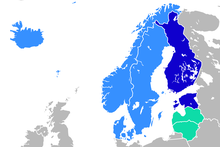202505 克里姆林宮加強芬蘭邊界布軍
(Alexander Stubb)警告克里姆林宮:“別耍特朗普總統 ‘You Don’t Play With President Trump’”---以他所謂的「謙遜的方式」介入烏克蘭和平進程 (《紐約時報》20250429)。他的角色只是「推動事情朝著正確的方向發展」並「努力將各個點聯繫起來」。 芬蘭經驗是烏克蘭最重要借鏡(《經濟學人(The Economist Nov. 23~29 2024 )及2025年展望》)。
在周日接受《紐約時報》採訪時,芬蘭總統亞歷山大·斯塔布 (Alexander Stubb)淡化了他對川普的影響。他指出,法國總統馬克宏和英國首相基爾·斯塔默正在領導歐洲的努力,而他的角色只是「推動事情朝著正確的方向發展」並「努力將各個點聯繫起來」。
In an interview with The New York Times on Sunday, Mr. Stubb downplayed his effect on Mr. Trump. He noted that President Emmanuel Macron of France and Prime Minister Keir Starmer of Britain were leading European efforts, with his role being merely to “nudge things in the right direction” and “try to connect the dots.”
THE WORLD AHEAD 2025 一書已出版,我猜錯了.....
讀《經濟學人(The Economist Nov. 23~29 2024 )及2025年展望》;芬蘭經驗是烏克蘭最重要借鏡。專業記者,網錄影片,客觀,有“評論,修正”等等,這些是社群媒體如Meta, X 等做不到的。醜陋的 Musk xAI 白刃戰
https://www.facebook.com/hanching.chung/videos/919210913149403
發射美製ATACMS命中俄機場!俄國防部認了:準備報復
北歐波羅的海八國(Nordic-Baltic Eight,簡稱NB8)爲丹麥、瑞典、挪威、芬蘭、冰島、愛沙尼亞、拉脫維亞以及立陶宛八個國家之間的區域合作組織。
歷史
[編輯]北歐理事會在1989年開始與波羅的海國家的議會接觸。1991年北歐理事會參與波羅的海會議於塔林舉行的成立儀式, 標誌著雙方的合作正式開始。1992年,雙方簽訂相關合作條約。[1]
北歐五國在歷史上強烈支持波羅的海三國的獨立;在波羅的海國家實現獨立後,北歐國家最早對其開放邊境,以及對其國民提供免簽證待遇。[2]同時,北歐國家亦開始協助波羅的海國家加入歐盟及北約。[2]
合作的初期,該組織被稱作 5+3 (5個北歐國家 + 3個波羅的海國家)。2000年8月30日,雙方於丹麥城市米澤爾法特展開外交部部長會議後,決定組織名稱爲NB8。[3]
Nordic-Baltic Eight (NB8) is a regional co-operation format that includes Denmark, Estonia, Finland, Iceland, Latvia, Lithuania, Norway, and Sweden. Under NB8, regular meetings are held of the Baltic and Nordic countries' Prime Ministers, Speakers of Parliaments, Foreign Ministers, branch ministers, Secretaries of State and political directors of Foreign Ministries, as well as expert consultations where regional issues and current international topics are reviewed.[2]
History
[edit]Historically, the countries of the region have been interlinked and interacted for centuries, with mutual trade being the decisive factor facilitating this interaction. The most profound bond, however was created during the 1990s.
The Nordic Council first contacted Baltic parliamentarians in around 1989. Official co-operation began in November 1991, when the Nordic Council attended the inaugural meeting of the Baltic Assembly in Tallinn. A formal co-operation agreement between the Nordic Council and the Baltic Assembly was signed in 1992.[3]
The Nordic countries were amongst the strongest supporters of the Baltic countries' independence and later they were the first to open their borders, introducing visa-free regimes with the Baltic countries.[4]
When Baltic countries regained their independence and during their integration into the European and transatlantic structures, they were strongly supported by their Nordic neighbors. The Nordic-Baltic co-operation took place in various levels: networking and cooperation were established among politicians, civil servants and civil societies. The Nordic countries actively assisted the Baltic countries in their preparations for integration into the European Union and NATO.[4]
Named as 5+3 in the beginning of cooperation (five Nordic countries plus three Baltic States), the format changed its name and scope of cooperation. During the meeting of the Ministers of Foreign Affairs of the Baltic States and Nordic Countries on 30 August 2000 in Middelfart (Denmark), the Ministers decided that the meetings of the Ministers of the Baltic States and Nordic Countries will be called NB8.[5]
Nordic–Baltic countries today
[edit]
The Nordic–Baltic community is one of the three main communities in Northern Europe: these are Nordic, Baltic and Baltic Sea Region.[6]
The Nordic–Baltic region has some 33 million inhabitants, and a combined GDP of close to $2.0 trillion,[7] which makes it the tenth-largest population and fifth-largest economy in Europe. Furthermore, the region features relatively low levels of corruption; with the Nordic countries being some of the least corrupt countries in the world. Also, the countries of the region place well in various international freedom rankings, with several of the states at the absolute top. The Nordic–Baltic countries also do well in surveys that measure the ease of doing business and creating new companies. The Human Development Index places many of the countries in the region among the most developed in the world.[8]
The Nordic–Baltic region is diverse, with a wealth of natural and cultural heritage, communities, destinations and resources. The region hosts a total of 42 World Heritage sites that are experiencing increasing pressures from tourism.[9] The Baltic states are described as three fascinating states that have glorious beaches along an extensive coastline, medieval old towns, and beautiful natural scenery, whereas the Nordic countries own spectacular scenery of mountains, lakes, archipelagos, glaciers, geysers, forests, waterfalls and volcanoes. There is much wilderness, including extensive arctic tundra.
 President Alexander Stubb of Finland has inserted himself in the Ukraine peace process in what he calls “a humble way,” regularly speaking with President Volodymyr Zelensky of Ukraine and also talking to President Trump.Credit...Saara Mansikkamaki for The New York Times
President Alexander Stubb of Finland has inserted himself in the Ukraine peace process in what he calls “a humble way,” regularly speaking with President Volodymyr Zelensky of Ukraine and also talking to President Trump.Credit...Saara Mansikkamaki for The New York TimesSkip to contentSkip to site indexSection Navigation
Finnish Leader Warns the Kremlin: ‘You Don’t Play With President Trump’
President Alexander Stubb of Finland, who has become an interlocutor in peace talks, says in an interview he doesn’t want Ukraine to suffer the same fate his country once endured.
President Alexander Stubb of Finland has inserted himself in the Ukraine peace process in what he calls “a humble way,” regularly speaking with President Volodymyr Zelensky of Ukraine and also talking to President Trump.Credit...Saara Mansikkamaki for The New York Times
沒有留言:
張貼留言